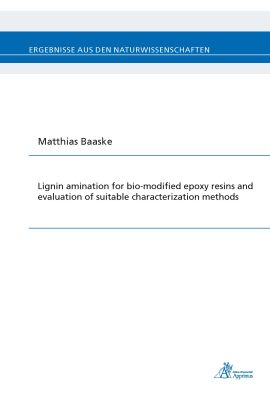The development work within this dissertation focuses on the field of investigation of "bio-materials" based on the renewable resource lignin, which is a bio-based polymer material. The utilization of lignin, a side product of the papermaking process, is a further step towards the gradual substitution of fossil raw material with renewable feedstock and the development of novel applications for biomass thereof. Different types of lignin with different quality as well as originating of different sources were analysed, characterized and utilized in different applications at the Department of Chemistry at the TU Darmstadt and at the Fraunhofer Institute for Structural Durability and System Reliability LBF (Division Plastics) in Darmstadt.
Detailed characterization techniques were developed for aminated lignin regarding to amino-content, chemical identity, structural identity, thermal stability and amount of functional groups attached to the lignin molecule accessible for cross-linking reactions. The present methods are illustrating a strategy, which facilitate a comparison of properties between amino-functionalized lignin and the raw materials. The well-known Mannich reaction was used for the one-step amino-functionalization of lignin material. Several optimizations of known reaction conditions led to the production of highly amino-modified lignin material. Hereby, common amino-based curing agents for epoxy resins were attached covalently to lignin's aromatic scaffold in order to provide a lignin-based hardener for epoxy resins with suitable cross-linking abilities. Lignin was purified prior to an amino-modification to guarantee the highest possible degree of substitution. Therefore, several purification methods were tested to detect the most promising purification method for lignin material. All resulting amino-modified lignin derivatives were analysed in detail, especially with respect to the amount of covalently bound amino-groups. Hereby, it could be stated, that DETA is covalently bound to lignin’s aromatic scaffold and two main structures of aminated lignin occur. First studies of aminated lignin aimed at the curing ability of aminated lignin with common epoxy resins to form lignin-based thermosets. This could be tested in several curing attempts, leading to a successfully cross-linked thermoset material. Due to the fact, that aminated lignin may become a suitable bio-based alternative for common curing agents, also the industrial benefit for amino-modified lignin was ensured as an upscaling process of the lignin amination via Mannich reaction was established and performed successfully. Consequently, the industrial benefit as well as the value of lignin material could be increased successively by successfully incorporation aminated lignin in epoxy resins, initializing new areas of application for bio-polymer material such as lignin.
| Autor | Baaske, Matthias |
|---|---|
| Lieferzeit | 3-4 Tage |
| Gewicht | 0.485 kg |
| Erscheinungsdatum | 16.02.2017 |
Dissertationen
Lignin amination for bio-modfied epoxy resins and evaluation of suitable charcterization methods
Kurzbeschreibung
This thesis unveils novel as well as optimized synthetic pathways for a one-step amino-functionalization of lignin material via Mannich reaction in order to form a bio-based curing agent for epoxy resins. The resulting amino-modified lignin derivatives were characterized explicitly and were optimized for utilization as amino-hardener for epoxy resins. This opens a new area of interest for incorporating lignin material as functionalized additive into epoxy resins. Thereby the benefit of biomass such as lignin can be increased and novel applications for lignin can be developed.

